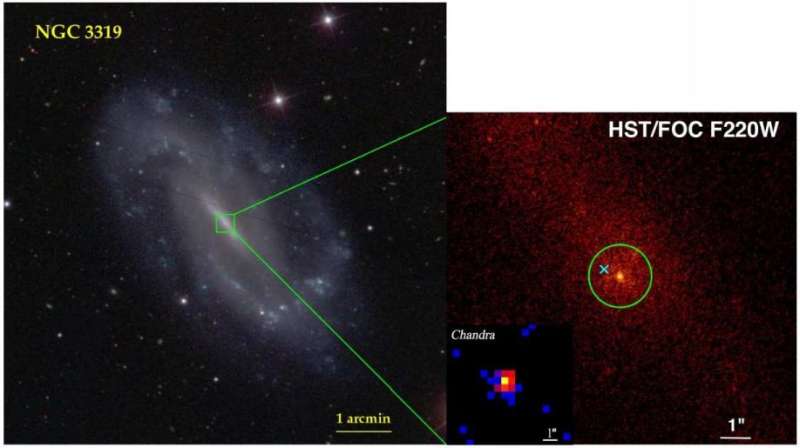November 5, 2018 report
Galaxy NGC 3319 may host an active intermediate-mass black hole, study finds

Chinese astronomers report new findings regarding the central region of a nearby galaxy known as NGC 3319. The researchers found an active intermediate-mass black hole candidate residing in the center of this galaxy. The discovery is detailed in a paper published October 24 on the arXiv pre-print server.
With masses ranging from 100 to 1,000,000 solar masses, the still elusive intermediate-mass black holes (IMBHs) could fill the gap between stellar-mass black holes and supermassive black holes (SMBHs). Given that the origin of SMBHs remains a mystery, IMBHs could be helpful in explaining this puzzle, as the most massive black holes are thought to be grown from much smaller "seeds."
Although the list of known IMBH candidates contains hundreds of objects and is still expanding, none of them has been confirmed yet. Such black holes are generally difficult to find due to the fact that radii of their gravitational influence are too small to be resolved spatially, even in nearby galaxies. Therefore, one of the methods used by astronomers to identify IMBH candidates is to search for dwarf active galactic nuclei (AGNs).
A group of researchers led by Ning Jiang of the University of Science and Technology of China in Hefei, conducted such search for AGNs by analyzing data provided by space observatories like NASA's Chandra X-ray observatory, ESA's XMM-Newton spacecraft and the NASA/ESA Hubble Space Telescope (HST). The study led to the detection of a promising IMBH candidate in the nearby barred bulgeless galaxy designated NGC 3319, about 47 million light years away.
"We report the discovery of an active intermediate-mass black hole (IMBH) candidate in the center of nearby barred bulgeless galaxy NGC 3319. The point X-ray source revealed by archival Chandra and XMM−Newton observations is spatially coincident with the optical and UV galactic nuclei from Hubble Space Telescope observations," the team wrote in the paper.
According to the study, the black hole in the center of NGC 3319 has a relatively low bolometric luminosity of about 36 duodecillion erg/s and an estimated mass most likely between 300 and 300,000 solar masses. These values allowed the researchers to initially classify the black hole as a faint IMBH candidate.
The authors of the paper noted that the newly detected candidate could be one of the least-massive IMBH candidates, as such objects identified so far have masses usually above 100,000 solar masses. However, further observations of NGC 3319 and its central region are required in order to determine the exact mass of its black hole, which should confirm whether or not it hosts an IMBH.
In concluding remarks, the astronomers emphasized the significance of their discovery, noting the uniqueness of the IMBH candidate in NGC 3319.
"The BH in NGC 3319 is a unique IMBH in terms of its close distance, low luminosity, high accretion rate, bulgeless host, and most interestingly the small central BH. Further observations are highly encouraged to get a more precise MBH," the scientists concluded.
More information: Discovery of An Active Intermediate-Mass Black Hole Candidate in the Barred Bulgeless Galaxy NGC 3319. arxiv.org/abs/1810.10283
© 2018 Science X Network





















